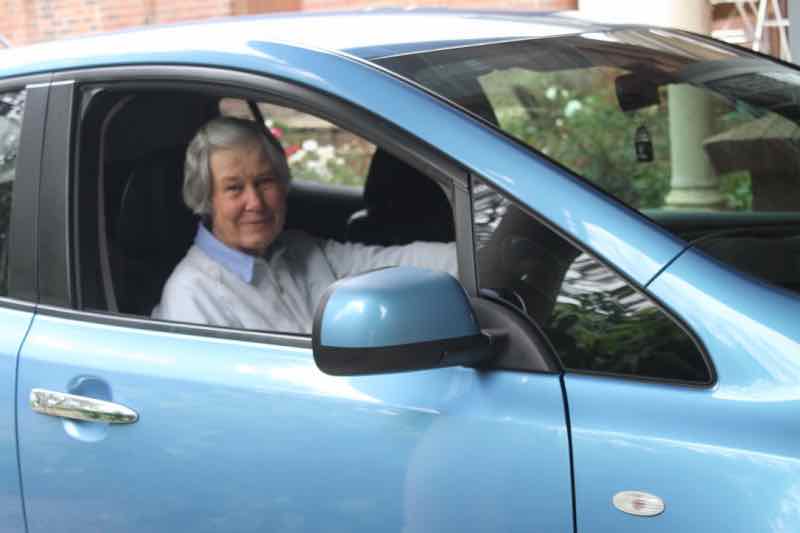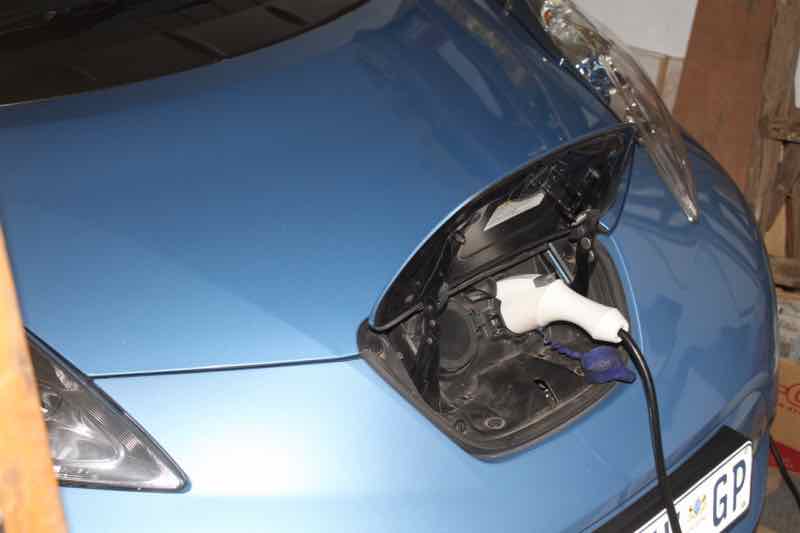- Bernard Preston homepage
- Our green solar power
- Turning Over a Blue Leaf
Turning over a blue Leaf
Turning over a blue leaf meant a Nissan-BEV[3] for us in January four years ago.
Many of you I expect will have discovered that the material-objects that we so desire often leave us feeling not a little flat after their arrival. Most of the fun is in the anticipation, the planning and choosing.
One of the great exceptions in my life was the ancient plywood glider that I bought some twenty-five years ago. It brought me such pleasure and once even lifted me on a particularly thermic day to 14,000 feet above sea level over Nottingham Road, on the way to Estcourt and back.
Our first E-car, a Nissan Leaf, has done exactly the same. It too is far from new though it does have an updated 30 kWh battery giving it a range of about 150 km around town, but less on the highway.

To prolong the life of the battery the manufacturer recommends you charge it only to 80% unless you are planning a longer trip. We could easily drive to Estcourt or Durban but would need to plug in before the return journey.
Battery electric vehicles and gliders have much in common. You can never be absolutely sure you are going to reach your destination, leaving something of a pit in the bottom of the stomach. It is the perfect car for short commutes. On the other hand, except for running out of battery power, E-cars are apparently twenty five times less likely to break down.
However unlike my glider, our Leaf is not going to be a toy; we have no desire to be left stranded on the roadside, never a good idea in South Africa. Considerable planning of our longer journeys will be necessary. Neither a glider nor an EV are the way to get to Cape Town. For that we have a small bakkie, and could always hire a larger car for a two-week family holiday.
And secondly both gliders and EVs use no fossil fuels; and there are no carbon emissions. They contribute to a greener planet and are one more step against global warming. One interesting feature is the regenerative braking. When I left Hilton the power-meter said that I could travel 117 km; by the time I had reached PMB, the battery was charged to such an extent that I could drive 153 kilometres. Of course, it did not like the climb back up the hill.
I read reports that the insurance on EVs is very high, but I was pleased to find that actually it was better value than the car we traded in. Nor was the license any more than an internal-combustion engine vehicle.
It takes 7 hours to charge the battery from flat, drawing 2 kW of power, about the same as a kettle; plugging into a conventional socket. At municipal charges that would be R14, or R20 on prepaid. Our solar inverter handles it magnificently, so for us running our Leaf costs nothing; nor will it trouble Eskom. Our current petrol bill used to be about R1500 per month on our old Honda that we traded in, so a significant saving.
In 2011 the Leaf was awarded World Car of the Year, but of course there are many new entrants to the market, though in SA the only alternatives are very expensive, the Jaguar and BMW options.
It’s seven years since the first Leaf appeared on the market; over 400,000 have been sold worldwide, saving 3.8 million barrels of crude oil per year apparently.A new Leaf e+, not yet available in SA, will cost a whopping R900,000.
It's sobering that in the USA the selfsame car with discounts will cost under $20,000[1].

The E-car has landed; right in our garage. There are still less than one thousand BEVs[2] in South Africa apparently.
With very few moving parts compared to an internal combustion engine, we are hoping for a good decade with very little maintenance; payback time with luck will be about five to seven years and after that free motoring. Turning over a blue Leaf is our small bit for a greener planet.
Turning over a blue Leaf
Turning over a blue Leaf in January, 2021 took on new meaning with our first battery electric-car; it was the next step in our green journey.
Saving for a solar farm by foregoing all luxuries for a year could mean all this could be yours. Going off the grid and turning over a blue leaf have been turning points in our lives.
- Nissan Leaf USA
- Electric vehicles
- BEV - battery electric vehicle.
When browsing use right click and Open Link in New Tab, or you may get a bad gateway signal.
Newsletter
Our newsletter is entitled "create a cyan zone" at your home, preserving both yourself and Mother Earth for future generations; and the family too, of course. We promise not to spam you with daily emails promoting various products. You may get an occasional nudge to buy one of my books.
Here are the back issues.
- Lifestyle and ideal body weight
- What are ultra-processed foods?
- Investing in long-term health
- Diseases from plastic exposure
- Intensive lifestyle management for obesity has limited value
- A world largely devoid of Parkinson's Disease
- The impact of friendly bacteria in the tum on the prevention of cancer
- There's a hole in the bucket
- Everyone is talking about weight loss drugs
- Pull the sweet tooth
- If you suffer from heartburn plant a susu
- Refined maize meal and stunting
- Should agriculture and industry get priority for water and electricity?
- Nature is calling
- Mill your own flour
- Bake your own sourdough bread
- Microplastics from our water
- Alternative types of water storage
- Wear your clothes out
- Comfort foods
- Create a bee-friendly environment
- Go to bed slightly hungry
- Keep bees
- Blue zone folk are religious
- Reduce plastic waste
- Family is important
- What can go in compost?
- Grow broad beans for longevity
- Harvest and store sunshine
- Blue zone exercise
- Harvest and store your rainwater
- Create a cyan zone at your home
Did you find this page interesting? How about forwarding it to a friendly book or food junkie? Better still, a social media tick would help.
- Bernard Preston homepage
- Our green solar power
- Turning Over a Blue Leaf
Address:
56 Groenekloof Rd,
Hilton, KZN
South Africa
Website:
https://www.bernard-preston.com